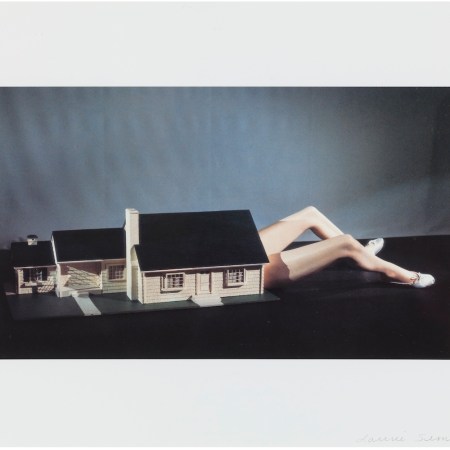The wise investor takes into account maintenance costs before purchasing.
That ‘65 Mustang Coupe? Her brakes are gonna go at some point. That second home in Playa? Hurricanes. That beauty queen second wife? Botox and Bordeaux ain’t free.
Same goes for art. You invested in it. Count on spending a little time and money preserving it.
To assist, we tapped the esteemed expert Tze Chun, founder of Uprise Art, an online gallery for the next generation of art collectors, to give us practical tips on maintaining and preserving your beloved works.
First off, the safest place for artwork is framed and on your walls (under your bed, not so much). Even so, the occasional ding can occur.
On the general rules of keeping art healthy and prosperous…
Whenever possible, frame your works. This may seem expensive for the neophyte collector, but you’re not in college anymore, and companies like Framebridge are very affordable. Make sure to use UV-protective plexiglass, which is less likely to crack than regular glass.
Location is key. You want work to look its best, so avoid heavily trafficked spaces where the work can be touched or bumped. It’s essential to avoid heat and smoke, which can damage even professionally framed works. And finally, depending on the medium of the work, it would be best to avoid placements that are subject to direct sunlight for more than two hours a day. This is especially true for watercolors, which can fade over time.
On pieces that might need extra TLC…
Some media require special care. Works on paper, such as photographs, should be framed with archival acid-free materials; dust can become permanently affixed to the glossy surface if neglected. Paintings are the easiest to maintain since oils and acrylics can be dusted lightly with a brush or feather duster. Just keep an eye out for flaking — more on that later.
Ceramics are made from more durable materials, so sunlight, heat and moisture are less of a concern. Cleaning is a cinch, assuming the work in question doesn’t have an unsealed, painted finish — just brush or dust the work the same way you would any other item in your home. Glazed ceramic pieces can be cleaned with soap and lukewarm water if needed.
On when to recruit professional assistance…
How can you tell when your artwork needs the help of professionals? One certain reason to seek out professional help is water damage, especially if you see visible mold on a canvas or other unframed work. This will require professional cleaning. With something like an oil painting, the cleaning process can restore color, especially for older works. Professionals can also help with tears, rips and even holes in canvas works by reattaching the fibers of the canvas or linen.
On how to go about selecting a pro…
If an artwork is damaged beyond your ability to repair it, it’s time to call in the cavalry. Before contacting a professional, make sure you educate yourself as thoroughly as possible about the work. This means knowing everything from size and medium to the date it was created and how it’s framed. Being able to provide this information will make it much easier to get a quote on the type of repairs you might require.
Reputable professionals can be found using the American Institute for Conservation (AIC), or by asking the gallery you acquired the work from to provide you with a pro they trust. Next, make sure the professional can see the work in person and give you a quote before you commit to their services. Always ask about which services are necessary and which would constitute bonus services. Avoid anyone who quotes a price but refuses to explain their specific plan or services.
On the cost of repairs…
The expense incurred by repairs and restorations will depend on many factors, but medium, size, age and the value of the work are the principal considerations. The best way you can ensure you’re not spending more money than the job is worth is to avoid companies that propose a flat fee per square inch — this means they’re not taking into account the nuance of your work. If this seems like an enormous cost, remember these restorations will always improve an artwork’s value.
On how often to maintenance…
Another thing worth considering: while some damage requires immediate attention — like mold or a puncture — professional artworks should last 100 years or more between professional restorations and cleanings. It is worth noting, though, that many of the current restoration techniques are products of 20th-century innovation, so if a piece hasn’t been restored or cleaned in the past 50 years, it’s worth checking for signs of degradation.
On what to consider before you buy…
When purchasing an artwork, it’s always good to inquire if the mount — be it canvas, muslin or panel — has been primed. This means that the paint sits on a layer of gesso or rabbit skin glue, which are archival materials whose use traces back to the Renaissance. Many artists in the 20th century did not use these materials, leading to difficulties for modern art museums in maintaining their collections. For example, the MoMA is constantly working to repair and restore works by Abstract Expressionists like Willem de Kooning, who worked on unprimed canvases.
If you’re purchasing an unprimed work, chances are in 10 years you’ll start to see the surface of the work change as the paint begins to peel. There are exceptions, so always ask your gallery about the durability of the work and the materials used.
One key way to ensure the works you collect can be maintained with reasonable ease? Always purchase from a gallery that has a close relationship with the artists they feature.
Whether you’re looking to get into shape, or just get out of a funk, The Charge has got you covered. Sign up for our new wellness newsletter today.























